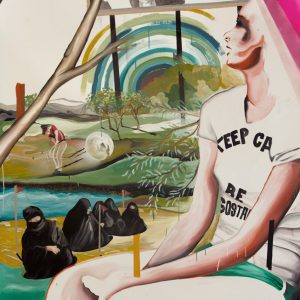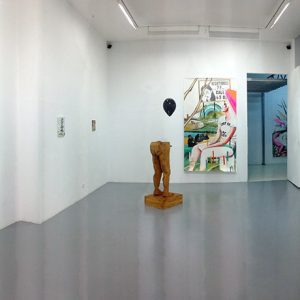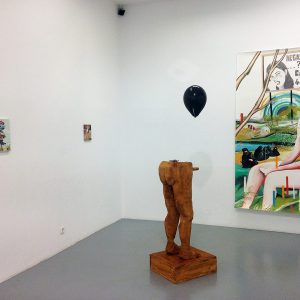Año: 2016
TOTEM NACH RUIZ
Normalcy is a highly praised concept. We all assume normalcy as the axis of our behavior; therefore, we are all normal. When something links many of us, we become "mass" and mass is obviously normal. It is the engine of social change: it moves the world. The mass was dissected by Elías Canetti and classified into groups that are difficult to dispute, although the concept has shown frequent revisions over the last century. Not long ago Sloterdijk resumed the line of thinking in which the mass is the uncritical support of ideologies and, therefore, the mother of totalitarianisms ¾something that was in the genesis of Canetti's ideas.
There is a moment when it is not clear whether the idea of normalcy is imposed by a leader on the mass or the mass, as a paradoxically autonomous entity, imposes normalcy on the leader. In this context, I am interested in two situations far away in time, but linked by an atavistic fear of the end of days. John of Leiden was a Dutch Anabaptist who had himself crowned King of Cologne by divine wish at the beginning of the 16th century. The city had risen under the command of Jean Matthijs and was besieged by the troops of Bishop Franz de Valdeck. When Matthijs died in a foolish departure to break the siege, our man had a revelation: he walked around the city naked for several days and changed the rules of life by instituting polygamy and a kind of germinal communism in which he was the very god himself. He subverted the rules and created a macro-community of fanatics who thought they were on the right track to save their souls when the imminent Day of Judgment came. For that mass, normalcy was set based on a collective delusion in which God spoke through the mouth of John of Leiden. This fact, studied by Norman Cohn and recovered by Greil Marcus in Lipstick Traces to trace the lineage of punk, is a fascinating moment in history in which it is almost impossible to determine if normalcy is that of those who considered themselves directed by god to change the world on quasi-anarchist rules or that of the besiegers, whom god had ordered to exterminate those within. Two opposing masses that are organized around a human totem, either Leiden or Bishop Valdeck. The history of history.
At the bottom of the events in Cologne is millennialism; the belief in the arrival of the end of the world as we know it to fulfill the third prophetic kingdom and give way to the thousand years of the rule of Christ at his second coming. It is a very common eschatological belief since the year 1,000. About nine centuries later, not far from Cologne, Hitler would proclaim the Third Reich, the one of the thousand years. Today, as then, many consider that the end is near and that it will surely be caused by an ecological cataclysm; they are victims of “Solastalgia”. Those who suffer from this new disease may go into a depression for fear of global warming and the awareness that humans have brought the world to the brink of annihilation. It is actually another form of millenarianism; only the prophet who speaks of the next thousand years of perfection has not yet appeared, or the figure may be atomized into thousands of little word bearers. History does not always repeat itself in all its nuances, it would be too predictable.
The contemporary solastalgia and the heresy of John of Leiden share a starting element: a mass that moves away from the prevailing normalcy to generate its own marked by the fear of the end of days. Once this is assumed, it is necessary to cling to something that brings hope, and the two lifesavers are usually actions that congratulate you with godnature and magical objects to hold on to. In these actions, prayer is the most frequent, but in case of an upcoming ecological cataclysm, the subject makes a deal with nature. Many become vegans, breaking an assumed normality: eating animals. However, that normality becomes a bit strange when children are fed chicken and then bought a stuffed chick. If a three-year-old is told that what he is eating is what he hugs to go to sleep and comes to understand the process by which millions of birds are slaughtered for consumption, we would undoubtedly mark their lives. Considering oneself vegan is an abnormality with respect to normality which, from the point of view of contemporary animalistic sensibilities, is another abnormality. Therefore, who can become the judge of the contest, who can contribute a normality above the obvious imperfections of normality itself? For many the answer to this question is divinity. But this is elusive, since it is in its nature to be elusive; therefore, God must speak through prophets —John of Leiden and all those who bring the end of the world to our lives— and be fixed through objects. The man loves objects at different levels, ranging from pure functional utilitarianism to a fetishism upmostly exacerbated by the religious object; there we find the raison d'être of the totem, an ancestral container for divinity.
All religions have a pantheistic element: God everywhere, nature as an expression of creation, the seven days of genesis, natural tragedies as punishment for sins... it is too strong a component not to have contaminated all contemporary thought. Almost all lines of thought today foresee a natural collapse, an end of the world in any of its colorful forms. Therefore, the totem is something to embrace to avoid the end, protect yourself, or plead with the divinity. A therapeutic object that magically defends the individual crushed by a normality doomed to an apocalyptic end. Yann Leto is a narrator of that crisis of normality that crushes the autonomous thinking of the individual. We tend to propose a relationship with images based on the ability to interpret codes. The totem launches an elementary message, of almost perfect readability, but in such complex times the interpretation of keys must go to a much higher level. When Georges DidiHuberman undertakes the task of decoding Bertolt Brecht's "The ABCs of War", he does so from a cultural reading of his collages of images taken from the press, in which the technical means serve a political task already contemplated by Walter Benjamin "not to supply the production apparatus but to transform it simultaneously" (Umfunktionierung or change of function). Brecht's photographic montages are a way of politically interpreting an elusive reality in all its complexity using individual stories together.
This non-innocent reading of the facts is one of the pillars on which Leto's work is built, not only because of the collision of images and stories as support for a meta-story. His work questions the prevailing "normalcy" from the observation of its gaps, of the shadow areas that make the hegemonic discourses inconsistent. Skepticism as a starting point. The medium is key in this case, painting as an ideological battle entity not attached to some master lines dictated from outside. This idea of painting as an element of production subjected to the pressures of the era of hyperconnectivity is a very suggestive factor that is added to the ancient debate of the medium as an ideological key. Picasso may not have read Hegel and later art should be grateful to him. The Hegelian line would have devoured everything and the answer would have come too late to avoid an intellectualized normalcy that would have had a disastrous end: the total solemnization of artistic processes. It is a paradox, since solemnity should be a consequence, not an end, but a large part of the artistic production driven from these parameters is born with a clear claim to solemnity that was not in the ideology and that leaves no room for questioning its own reality, is too often exclusive. And often boring. Leto fights solemnity by understanding that monolithic readings are usually the petrification of a good idea, but sometimes of a mere occurrence. In these monoliths - ideological totems - the lack of fissures is annoying if it starts from the non-acceptance of a prevailing normalcy.
Working in the loopholes opens perspectives for systematic doubt and at this point irony is a critical process that serves to protect against consensus, that tar pit in which the individual becomes a mass. Dissent will make us free, it will allow us not to believe. Woody Guthrie writes “This machine killsfascists” on his guitar as Lemmy and Kippenberger race through the Bordeaux cellars on trail bikes. They run out of gas, but they don't care. The adventure must be fast as the consumption of images is fast, it must be fierce because, otherwise, it would not be an adventure and if it were not an adventure life would be shit. Consequences should not be thought about because consequence and consensus share the prefix "with" which means "jointly" And the whole is the basis of the mass. And the mass the support of normalcy.









